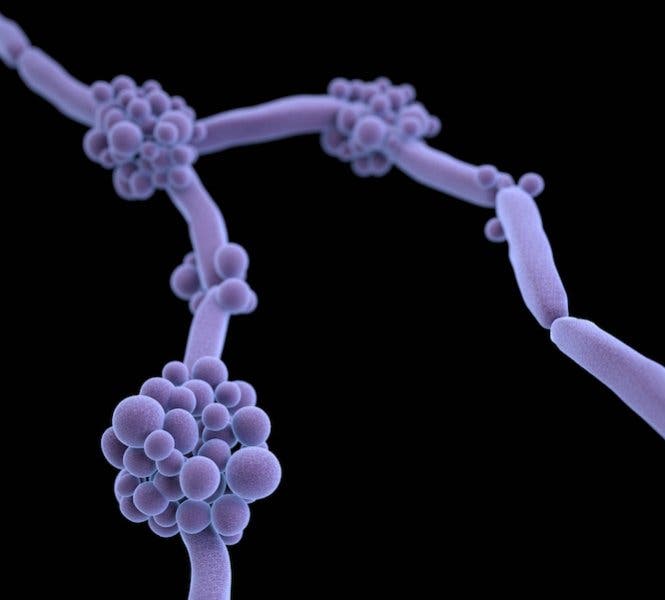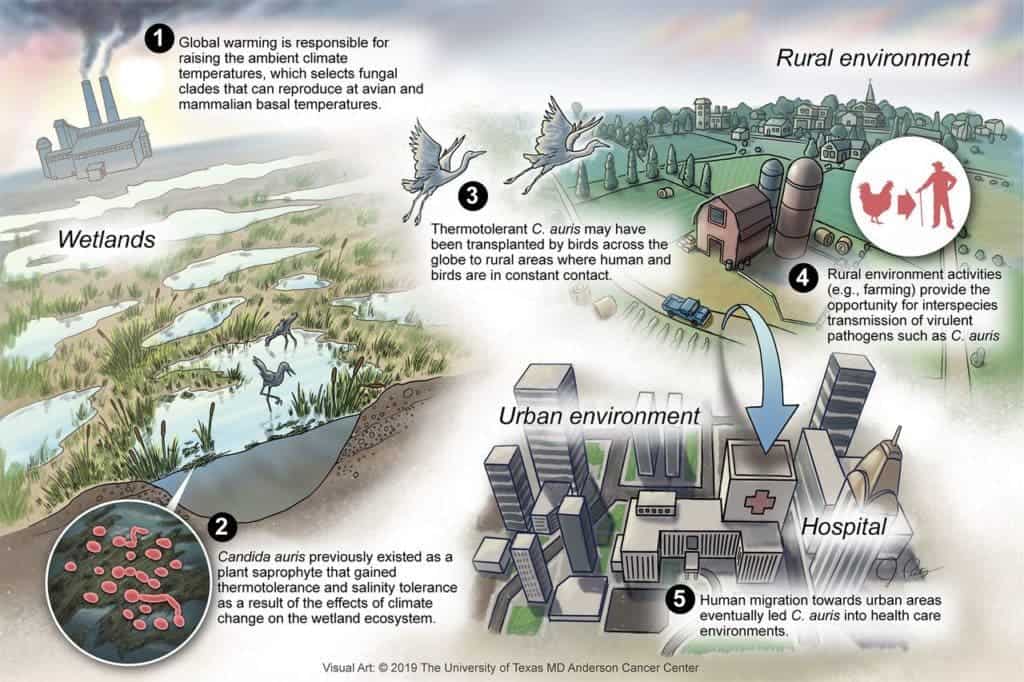A pathogen which can cause dangerous and potentially fatal infections is receiving a boost from rising temperatures.

Candida albicans, which is related to Candida auris, is also a pathogen. Candida are ranked as one of the most common groups of organisms that cause hospital-acquired infections. Image credits: CDC.
Heating up
When it comes to the multi-drug-resistant fungus Candida auris, few things are looking good. According to the CDC, several countries have reported that this fungus (technically, a yeast) is causing severe illness in hospitalized patients. C. auris is difficult to detect with standard equipment, can cause dramatic outbreaks (especially in hospital facilities), and is extremely difficult to treat.
To make matters even worse, global warming is making it even more difficult to treat, researchers say.
“The argument that we are making based on comparison to other close relative fungi is that as the climate has gotten warmer, some of these organisms, including Candida auris, have adapted to the higher temperature, and as they adapt, they break through human’s protective temperatures,” said Arturo Casadevall, MD, Ph.D., Chair, Molecular Microbiology and Immunology, Johns Hopkins Bloomberg School of Public Health, Baltimore, Maryland. “Global warming may lead to new fungal diseases that we don’t even know about right now.”
The idea that climate change is bringing out more diseases is not new at all. For starters, some pathogens hidden in the permafrost ice are starting to wake up as the ice melts — it’s uncertain just how impactful this will be, but there are legitimate concerns about this phenomenon. Secondly, rising temperatures and the shifting weather patterns favors the expansion of disease-carrying insects’ range — particularly mosquitoes. We’re starting to see malaria and West Nile virus spread in new areas as mosquitoes adapt to habitats which were previously inaccessible to them. Thirdly, as is the case here, rising temperatures are helping pathogens bypass our bodies’ natural defenses.
Dr. Casadevall explains:
“The reasons that fungal infections are so rare in humans is that most of the fungi in the environment cannot grow at the temperatures of our body.”
Our body temperature is not a random result of evolution. Recent studies have suggested that it’s a perfect balance — warm enough to prevent fungal infection, but not so hot that we have metabolic issues. It’s not just humans: all mammals are generally resistant to fungal diseases due to high body temperatures (compared to other creatures), which are efficient defense mechanisms.
However, global warming might be taking that away from us.
Strange yeasts (and where to find them)

A proposed scheme for the emergence of C. auris, favored by global warming and urbanization. Image credits: Casadevall et al / mBio.
Most fungi are found in a variety of places — soil, insects, plants, animals — but the only place C. auris has been found to date is in people. So our bodies and the pathogens are pitted in a constant fight, and rising temperatures are giving the fungus the edge.
Human-pathogenic fungi constitute only a very small minority of the entire fungus group, but that’s not the weirdest thing about it.
“The most enigmatic aspect of the rise of Candida auris as a human pathogen is that it emerged simultaneously on three continents, with each clade being genetically distinct,” researchers write.
Basically, C. auris seems to have evolved independently on three continents: India, South Africa, and South America. It’s unclear exactly how (and why) this happened, especially as researchers had only isolated the first specimens in 2009. Another thing which is unclear about it is just how dangerous it is.
According to the CDC, C. auris can kill 30-60% of the people it infects, which sounds absolutely horrifying. However, at least in the developed world, it only seems to infect individuals already suffering from serious conditions (such as those in intensive care units). It’s difficult to say how much of the damage is caused by the pathogen itself, and how much is caused by the previous conditions.
At any rate, rising temperatures are aiding the yeast.
In the new study, researchers compared the thermal susceptibility of C. auris to some of its closest relatives. They found that C. auris is capable of growing at higher temperatures than most of its relatives. Adaption to higher temperatures is one contributing cause for the emergence of C. auris, the team says, and global warming is probably one of the main contributors to this .
The team calls for more monitoring and study of C. auris as well as its nonpathogenic relatives, to better understand its dangers and learn new ways to combat it, even as it adapts through global warming. Researchers stress that while global warming is an important factor for the emergence of this yeast, it doesn’t tell the whole story.
“Although global warming-related changes in the environment might have played a prominent role in C. auris’s emergence, this variable is unlikely to explain the whole story,” the study concludes.
The study was published in the journal mBio









